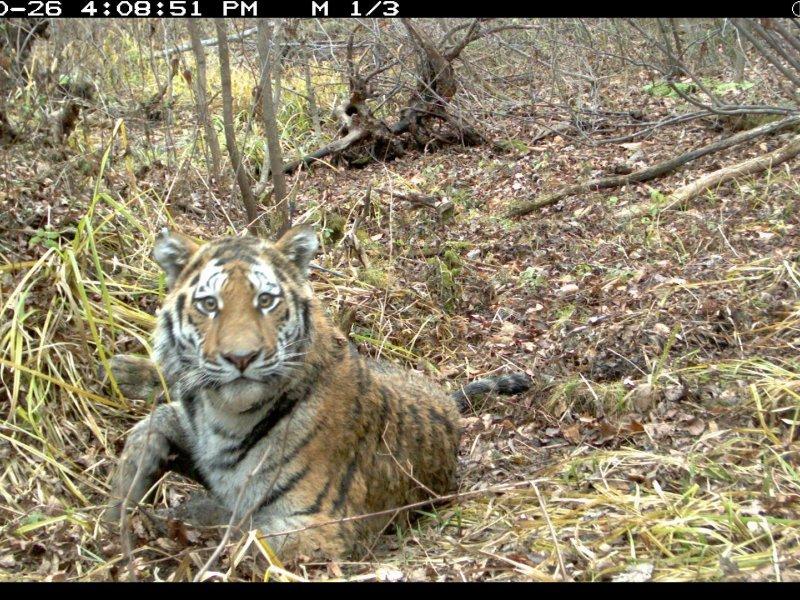
At the beginning of this year, the peer-reviewed scientific journal Animals published an article “Is the Lesser Khingan suitable for the restoration of the Amur tiger group? Perspectives in terms of habitats and food supply”. The article was prepared based on the results of the work of a joint project of the IEE RAS and the Institute of Natural Resources and Ecology of the Academy of Sciences of Heilongjiang Province (PRC) and is devoted to the assessment of existing biotopes in the area of the historical range of the tiger - the Lesser Khingan mountain system.
The results of the study showed that the territory of this mountain system can provide highly suitable habitats for 20-40 Amur tigers, depending on their sex and age. The degree of fragmentation of the habitats of the Amur tiger is also assessed and recommendations are given for organizing intra- and transboundary ecological corridors that will increase the migration permeability of the territory, thereby ensuring genetic exchange between tiger groups.
The mountain system of the Lesser Khingan has a geographical connection with that of the Greater Khingan and the Stanovoy Range and is one of the three transboundary mountain systems that cross the Amur River basin in the meridional direction. The territory is remarkable in that it has a high floristic diversity, since it is located at the junction of the Daurian, Manchurian and South Manchurian floristic regions. The low mountains, covered with forests of such a multicomponent composition, have always been included in the category of habitats that are attractive to both wild ungulates and tigers. Due to the effective development of this territory by humans over the past 70 years, tigers have not been observed here, although they were once common representatives of the fauna. During the implementation of the IEE RAS project (2013-2015) to restore the population of the Amur tiger in the north-west of its range in Russia by releasing orphaned tiger cubs specifically prepared for life in the wild in the Amur and Jewish Autonomous Regions (Rozhnov et al., 2021 ) some tigers and their descendants swam across the Amur and visited the territory of China in the region of the Lesser Khingan Mountains. Thus, the success of the implementation of the Russian project also initiated cross-border scientific Russian-Chinese cooperation.
The Amur tiger belongs to the category of “key species/indicator species” in many respects: it is endangered, listed in the Red Books of the Russian Federation and China, and on the IUCN Red List. The northwestern part of its range is located in both Russia and China, where the tigers were destroyed by humans. In order to plan for the restoration of the tiger population within the historical range, we first of all assessed the condition and suitability of habitats for tiger prey species (wild ungulates) in the Lesser Khingan Mountains (northern China), which became the starting region for our study. We carried out modeling of suitable habitats and calculations of the degree of their fragmentation, based on satellite imagery information and data collected by us during field expeditions in 2017, 2018, 2019. The resulting species distribution maps were used to build the ecological frame of the study area. The best quality habitats (for the tiger) were designated as ecological network cores, which were connected by calculated green corridors.
The results of the work confirmed the possibility of implementing a project to restore the Amur tiger in the Lesser Khingan Mountains in China. As estimated during the study, habitats with a high fitness index value are 19,327.6 km2. According to preliminary estimates, at least 20 males or 43 females can form their habitats on them (the size of the habitats of individuals according to Hernandez-Blanco et al., 2015); the rest of the calculations will depend on the sex ratio. Natural green corridors for tiger movement are located mainly at the
edges of forests and are characterized by high variability of tree species. This study describes three potentially significant transboundary corridors and makes recommendations for the establishment of specially protected natural areas (PAs) in the most significant tiger habitats: (a) the foothills and low mountains of northern Lesser Khingan; b) the section between the southeastern Lesser Khingan and the western part of the Wandashan mountain system; (c) a corridor in the foothills and low mountains of the eastern part of Lesser Khingan. Establishment of specially protected natural areas here will make it possible to conserve associated complexes of forest tracts in those places where currently there are no protected areas. In addition, recommendations are provided for tiger habitat restoration activities in key areas.
Ссылка: Yachmennikova, A.; Zhu, S.; Kotlov, I.; Sandlersky, R.; Yi, Q.; Rozhnov, V. Is the Lesser Khingan Suitable for the Amur Tiger Restoration? Perspectives with the Current State of the Habitat and Prey Base // Animals 2023, 13, 155. https://doi.org/10.3390/ani13010155
